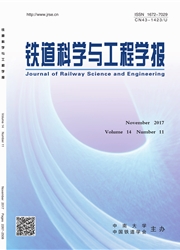

 中文摘要:
中文摘要:
针对目前在厂矿铁路外围平交道口中走行轨轨腰处和轨头下颚的裂纹,建立平交道口中走行轨及其横向支撑的有限元模型,分析了不同横向支撑条件(无支撑、倒放钢轨连续支撑、倒放钢轨间断支撑、连续刚度支撑、间断点弹簧支撑)下荷载冲击处钢轨断面内从轨腰底部至轨头下颚处的应力和位移。研究结果表明:在重载汽车冲击作用下,若走行轨的横向支撑刚度不足或横向支撑未顶实,则导致走行轨的轨腰处垂向应力过大,出现裂纹,在荷载反复作用下裂纹沿走行轨线路纵向发展,且走行轨的轨头最大横向位移为2.4 mm,危及行车安全;在直线地段的平交道口,采用倒放钢轨连续支撑走行轨效果较好;在曲线地段的平交道口地段,建议采用刚度为50~100 kN/mm的连续横向支撑材料代替倒放钢轨。
 英文摘要:
英文摘要:
The rail crack between rail head and the bottom of rail web usually appeared on level crossing outside of industrial railways. This paper established the finite element model of level crossing to analysis the stresses and displacement of running rail under the condition of different lateral support (unsupported, continuous support with upturned rail, continuous support with different stiffness, discontinuous spring support). The results showed that small lateral support stiffness and lateral without support led to the large vertical stress of running rail web under the impact of the heavy-duty vehicle load. It will lead to the rail crack. The crack expand along the vertical line of running rail under the effect of repeated loading, and the maximum lateral displacement of running rail head was 2.4 mm that affected the running safety. It is better to support running rail with upturned rail on the straight line section of level crossing. On the curve section of level crossing or considering other materials instead of upturned rail, this paper recommended that the continuous support materials that its stiffness of 50~100 kN/mm instead of upturned rail.
 同期刊论文项目
同期刊论文项目
 同项目期刊论文
同项目期刊论文
 期刊信息
期刊信息
